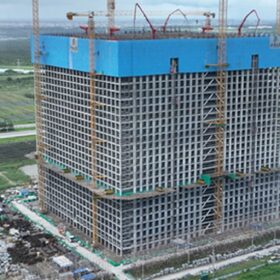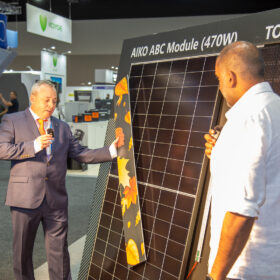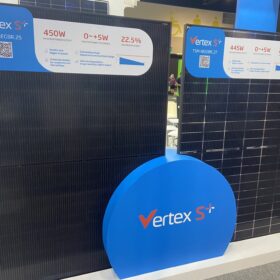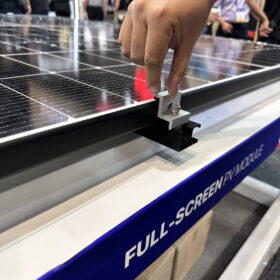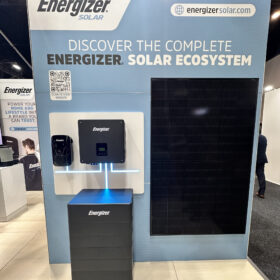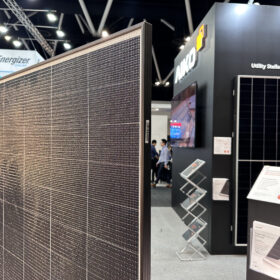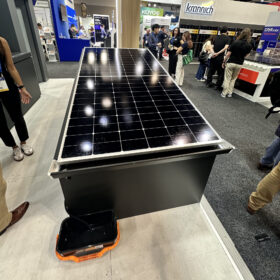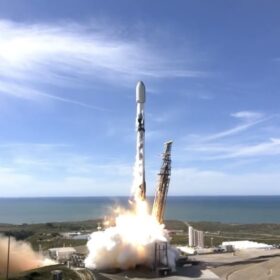Energy Vault connects commercial-scale gravity energy storage system in China
Energy Vault has connected its 25 MW/100 MWh EVx gravity-energy storage system (GESS) in China. Once provincial and state approvals are obtained to start operating, it will become the world’s first commercial, utility-scale, non-pumped hydro GESS. Meanwhile, its partners China Tianying (CNTY) and Atlas Renewable Energy have begun construction on three grid-scale GESS in China.
China’s Aiko to deliver 2 GW of All Back Contact modules to Australian shores from March
Chinese manufacturer Aiko showcased its GEN 2 N-type ABC (All Back Contact) modules at last week’s Smart Energy Expo, where the technology’s shade optimisation, enabled by its cells’ bypass diode function, made a splash. Pv magazine spoke to Aiko’s leadership about how its technology works and how the Australian market entrant plans to position itself down under.
Trina presents all-black 450 W solar modules with 22.5% efficiency
Solar technology manufacturer Trina Solar has developed an all-black version of its Vertex S+ solar module range that has a power output of up to 450 W with maximum efficiency of 22.5%.
Perovskite-perovskite-silicon tandem solar cell achieves record-breaking efficiency of 27.1%
Researchers in Singapore have built a triple junction tandem solar cell with an ultrawide-bandgap perovskite absorber integrating cyanate (OCN) ions. The cell surpassed the power conversion efficiencies previously reported for all other perovskite-based triple-junction tandems, as well as single-junction perovskite and silicon solar cells.
DAH Solar enters Australian market with anti-dust module range
Chinese solar manufacturer DAH Solar has launched into the Australian market with an anti-dust solar module with lowered frames, similar to that displayed by Longi just a few metres away during the Smart Energy Expo.
Energizer Solar’s new hybrid battery & inverter land in Australia, launching its home ‘ecosystem’
Energizer Solar, the licensee for US battery giant Energizer, has selected Australia as the first market to launch its renewable home ‘ecosystem.’ Including new hybrid inverters, a hybrid battery, solar panels, and soon an EV charger, the product suite has been certified and is landing on Australian shores “as we speak,” Gavin Owen, Energizer Solar’s Head of APAC Sales, told pv magazine Australia.
Smart Energy Expo: 8.8kg glass-free module launched by China’s Aiko
Chinese solar manufacturer Aiko has introduced an ultra-lightweight 8.8kg module to the Australian market. Aiko has swapped solar glass for high chemical plastic, affording the 450W ‘Air Series’ module its light weight.
Smart Energy Expo: Longi launches anti-dust module for C&I segment
Chinese solar manufacturer Longi has launched a new ‘anti-dust’ module. The feature rests on its design where the frame sit flush with the glass on the short side, allowing water to wash off unimpeded.
CSIRO takes solar cell research into space
Printed flexible solar cell technology developed by Australia’s national science agency has been successfully launched into space as part of billionaire Elon Musk’s Space X’s Transporter-10 mission.
RAPAD search for landholders to play part in 4.2 GW clean energy corridor
The developers of a proposed a “clean energy corridor” in Queensland’s central west that promises 4.2 GW of solar, grid-scale battery storage and a high-voltage transmission line are calling on landholders in the region to now register their interest in hosting renewable energy projects.
